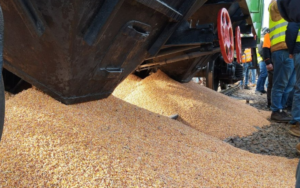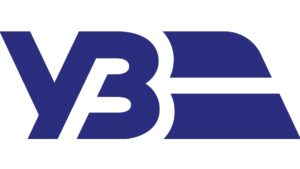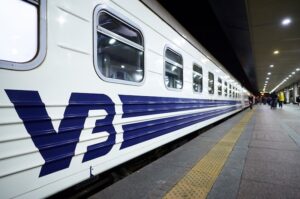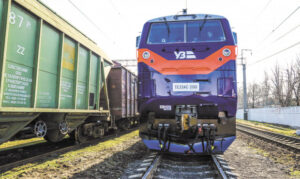
Due to the nighttime shelling of the railway infrastructure in Poltava region, Kharkiv-bound trains are still running with delays, and there will be a delay in the departure of return trains on Sunday evening, Ukrzaliznytsia reported.
According to a message posted on Telegram, trains #21/22 Kharkiv – Lviv (+10:34); #103/104 Kramatorsk – Lviv (+10:34); #1/2 Kharkiv – Ivano-Frankivsk (+10:06); #201/202 Kharkiv – Vorokhta (+10:06); #63/64 Kharkiv – Lviv (+4:57); #111/112 Izyum – Lviv (+4:57); #112/111 Lviv – Izyum (+2:25) are delayed.
Also in the evening, flight #64/63 Lviv – Kharkiv will depart from the terminal station approximately 2 hours later than its schedule; # 112/111 Lviv – Izyum will depart from the terminal station approximately 2 hours later than its schedule; # 2/1 Ivano-Frankivsk – Kharkiv will depart from the terminal station approximately 3 hours later than its schedule; # 202/201 Vorokhta – Kharkiv will depart from the terminal station as scheduled, but will receive an unscheduled parking at Ivano-Frankivsk station lasting about 3 hours.
Earlier it was reported that on the night of August 4, as a result of shelling in Poltava region, the railway infrastructure was damaged, a number of Kharkiv trains changed their routes and are running with delays.

JSC “Ukrzaliznytsia” (UZ) has made changes to the schedule of two Intercity+ trains on the Kyiv-Premysl route to reduce the risk of delays at the border.
“Starting August 10: train No. 715 Kyiv-Premysl will depart from Kyiv at 11:26 instead of 11:59. Train No. 705 Kyiv-Premierzl will depart at 19:19 instead of 20:05,” the company’s press service posted on Facebook on Thursday.
At the same time, as indicated, the arrival time of both trains to Przemyśl will not change. The additional time will be used to extend the stop at Lviv station for border and customs control.
Due to the high traffic, Ukrzaliznytsia advises passengers to allow at least 2-2.5 hours for the transfer.

In the marketing year 2023-2024 (MY, June-July), Ukrzaliznytsia JSC (UZ) transported 35.122 million tons of grain cargo, the best figure in the last four years, said Valery Tkachev, Deputy Director of Transportation Technology and Commercial Work Department of UZ, at a meeting with agricultural market participants on Thursday.
According to him, in June, 3.48 million tons of grain were transported by rail in all directions, a third more than in the same month of 2023.
In the first six months of this year, UZ transported 21.85 million tons of grain, which is 30% more than in the same period last year.
At the same time, 2.558 million tons of grain were transported in export traffic in June, and 18.731 million tons in six months, which is 43% more than a year earlier.
Export volumes of oil and oilcake and meals also increased. Thus, in January-June 2014, 954 thousand tons of vegetable oil were transported by rail, which is 30% more than last year. During the same period, the transportation of oilcake and meal increased by 19% to 1.41 million tons, Tkachev summarized.

Ukrzaliznytsia JSC (UZ) has changed the opening time of online sales for international trains to reduce the load on the application, the company’s press service reports.
“We are changing the opening time of online sales for international trains to stabilize the slightly overloaded application,” the press service said in a statement on Wednesday.
It is noted that from Thursday, ticket sales in the Polish direction (Przemyśl, Dorohusk, Chełm, Warsaw) will start at 09:00, with a sales period of 20 days before the departure date.
Slovak and Austrian direction – from 08:00, 20 days in advance. Ticket sales for trains to Moldova will start at 08:00, with a sales depth of 30 days.
“All sales start simultaneously on the Ukrzaliznytsia website and in the app. The opening of sales for all domestic flights will remain at 08:00,” UZ said.
The company explained that prior to these changes, ticket sales for all international trains opened at 8 am, except for the Kyiv-Warsaw train, which started selling tickets at 9:00 am.
“The changes will help reduce peak loads on our systems and, accordingly, make the use of the (…) application even more convenient and faster,” UZ assured.
UZ also reported that it has begun a gradual transfer of ticket sales to the new website https://booking-new.uz.gov.ua. International tickets will no longer be available on the old website.

JSC “Ukrzaliznytsia” (UZ) has created a separate legal entity – “UZ Energo” LLC, which will be engaged in the construction of gas-fired power plants. construction gas-fired power plants with a total capacity of up to 250 MW in the regions, the company’s press service reported.
“A decision has been made to construction of dozens of gas-fired power plants with a total capacity of up to 250 MW. As of today, Ukrzaliznytsia is holding active negotiations with suppliers and international financial organizations for the rapid implementation of this project,” the press release quoted Yevgeniy Lyashchenko, head of the UZ board, as saying.
According to the press release, UZ Energo will be 100% owned by Ukrzaliznytsia through Sales Energy Ltd, which is also owned by UZ.
Lyashchenko reminded that UZ is among the top 5 largest distribution companies in Ukraine in terms of network length and volumes of electricity flow.
The report says that UZ, as one of the largest consumers of electricity in Ukraine, is experiencing a significant deficit in its supply on an equal footing with everyone else. The introduced limits for electricity consumption cover the real needs of the company only by 75%.
They pointed out that with the approach of the fall-winter period, the increasing deficit in electricity supply may affect the uninterrupted movement of trains and adversely affect the provision of public services for household consumers. “UZ” is also the operator of water supply distribution for a number of consumers.
According to the report, gas-fired power plants will first of all be installed in regional centers and connected to the company’s networks, from which are powered railway transport facilities, social sphere, as well as critical infrastructure facilities of other sectors of the economy.

The European Bank for Reconstruction and Development (EBRD) will provide an additional EUR300 million loan to Ukrzaliznytsia (UZ) for the purchase of 80 modern electric freight locomotives, the UZ press service said on Wednesday.
The agreement, which the company announced in late May, was backed by a memorandum between Ukrzaliznytsia, the EBRD and the Ministry of Community Development, Territories and Infrastructure, which was signed in Berlin on the sidelines of the Ukraine Recovery Conference (URC2024).
“The issue of renewing the locomotive fleet for Ukrzaliznytsia is critical and crucial (…) Obtaining new and high-tech electric locomotives will significantly increase the efficiency of freight transportation,” said Yevhen Lyashchenko, chairman of the board of UZ.
At the end of May, the company announced the allocation of a $190 million grant from the United States through the World Bank Trust Fund as part of the Restoration of Critical Logistics Infrastructure and Network Connectivity (RELINC) project.
The proposal for the purchase of 80 electric locomotives with a total value of about $400 million has already been published on the EBRD tender portal. The tender requirements stipulate that the winner, in addition to supplying the locomotives, must create conditions for their maintenance and warranty repair in Ukraine.